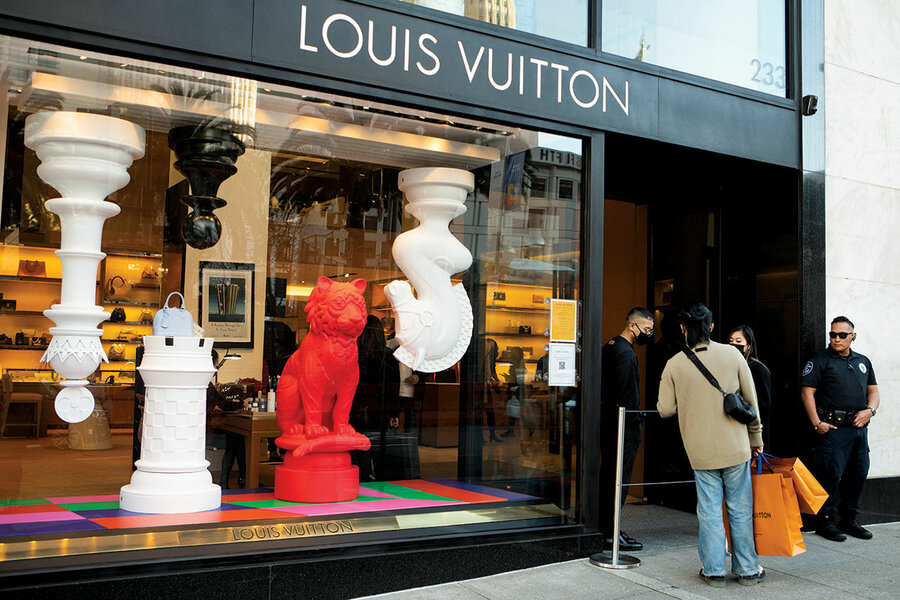Shoplifting is on the rise. So are solutions.
Loading...
As a woman exits a Seattle clothing store, the security tags inside her shopping bag trigger an alarm.
She runs. A security guard gives chase.
Why We Wrote This
A story focused onHigh-profile cases of shoplifting seem to be everywhere. Policymakers, researchers, and businesses are all trying to both assess and solve the problem.
“Between 9 a.m. and 8 p.m., I say we probably catch 10 to 12 [thieves],” says the guard, who asked not to be identified.
As shoplifting rankles concerned citizens and business owners alike, efforts are rising to both assess the problem and find solutions.
The National Retail Federation found that inventory loss amounted to $94.5 billion in 2021. Some say this is hardly cause for alarm: This rate of “shrink,” averaging 1.4% of revenue, is similar to previous years.
Others see crime on the rise. When Business.org surveyed 700 small-business owners, it found a 54% spike in peak-season shoplifting in 2021. New York City reported a similar jump in shoplifting complaints between 2021 and 2022.
Some stores have started locking everything up in plexiglass. Power tools sold at Lowe’s only work once the bar code gets scanned.
A new federal law requires online marketplaces like eBay to verify the identity of high-volume third-party sellers, in a bid to trace organized groups that sell stolen goods online.
Seattle is focusing on repeat offenders. Result? A year into the initiative, the city attorney reported 750 fewer police referrals and thousands fewer criminal incidents.
At a clothing store in downtown Seattle, a woman approaches the exit during the busy lunch hour. A security guard smiles at her. But when she passes through metal detectors at the store entrance, security tags inside her shopping bag trigger an alarm.
“Ma’am?” says the security guard.
Without turning around, the woman starts running. The guard dashes after her and stops her on the street outside.
Why We Wrote This
A story focused onHigh-profile cases of shoplifting seem to be everywhere. Policymakers, researchers, and businesses are all trying to both assess and solve the problem.
“She actually did purchase a couple items, but she also stole a couple items,” says the security guard, who asked not to be identified. “Between 9 a.m. and 8 p.m., I say we probably catch 10 to 12 [thieves].”
This kind of stealing isn’t confined to just urban Seattle. Across the United States, retailers are undertaking extraordinary measures to combat a rise in shoplifting, from locking goods behind plexiglass to installing specialty surveillance cameras.
There’s no shortage of demand for stolen goods due to “the increased inflation/ financial stress that people are experiencing right now,” says Christopher Herrmann, associate professor at John Jay College of Criminal Justice in New York.
How big a problem is retail theft?
The latest annual report by the National Retail Federation found that inventory loss amounted to $94.5 billion in 2021. Some say this is hardly cause for alarm. This rate of “shrink,” averaging 1.4% of revenue, is similar to the previous five years.
“Whether it’s some of the data that has come from retail theft organizations or others, we need to be careful about understanding what the data tells us,” cautions Miriam Krinsky, executive director of Fair and Just Prosecution, a nonprofit that advocates an “equitable and compassionate justice system.”
Retail shrink, in fact, includes everything from shoplifting and customer fraud to employee pilfering and inventory accounting mistakes. Still, the retail federation’s latest survey also reported a 26.5% increase in incidents of organized retail crime. A lot of this large-scale theft consists of under-the-radar looting such as cargo theft. Some of it is smash-and-grab theft by mobs. But a link between lone-actor shoplifters and organized crime rings is that serial offenders often sell their stolen wares to fences.
Other reports confirm the trend of thefts on the increase. When Business.org surveyed 700 small-businesses owners, it found a 54% spike in peak-season shoplifting in 2021. And while there aren’t comprehensive law enforcement figures, New York City revealed a 44% increase in shoplifting complaints between 2021 and 2022, part of a rising trend since 2018.
What are stores doing about it?
Inside pharmacies and big-box stores, it’s increasingly common for shopping aisles to be encased in plexiglass.
Earlier this year, a Walgreens executive told an anti-theft summit in Manhattan that “the locks work.” Well, mostly. A man recently walked into a Walgreens store in nearby Queens and used a blowtorch to open locked plastic cases. Other thieves use crowbars. One downside of the lock-and-key approach is the inconvenience of asking a store employee to open the glass doors.
“If it cuts down on the retail theft, then maybe it’s not a bad thing,” says Mr. Herrmann, the associate professor at John Jay. “At the same time, that’s when people like me would rely on Amazon.”
Other stores are employing high-tech solutions such as face recognition cameras. Clothing stores are using ink-filled tags that explode when thieves try to remove them. Power tools sold at Lowe’s will only work once the bar code gets scanned at the cash register.
In June, a Walgreens in Chicago unveiled what media reports described as an “anti-theft store.” Most products are only available for pickup at the counter after customers select and buy them on automated kiosks. Meanwhile, a Safeway grocery store in Vallejo, California, recently pioneered its own tactic: metal gates at the store exit facing any shoplifter trying to escape.
Experts say security professionals need to be taught how to safely deter theft.
“If you see someone shoplifting, you go up to them and you still offer them customer service. You let them know, ‘Hey, sir, you know that those sunglasses you put in your jacket? Do you mind if I hold on to them while you continue to shop?’” says David Rey, author of “Larceny on 34th Street: An In-Depth Look at Professional Shoplifting in One of the World’s Largest Stores.” “You’re not being accusatory. You’re letting them know, ‘I saw what you did.’”
Are there policy solutions?
A new federal law, the Inform Consumers Act, took effect in late June. The law requires online marketplaces such as eBay and Amazon to verify and share the identity of high-volume third-party sellers on their platforms. It’s a bid to trace organized crime groups that fence stolen goods online.
“If I’m on that Amazon third-party platform, I might get caught this time with my dummy account selling, you know, a Makita power source that I stole out of one of these home improvement centers,” says Mark Johnson, senior vice president of policy at the Washington Retail Association.
The National Retail Federation wants Congress to establish a dedicated retail crime unit at Homeland Security Investigations. Thomas Hogan, an adjunct fellow at the Manhattan Institute and a former district attorney in Chester County, Pennsylvania, says that a more efficient solution is to get tough on crime at a local level. He criticizes a new wave of progressive prosecutors who won’t prosecute shoplifters unless the value of their stolen goods reaches a higher threshold than before. Under California’s Proposition 47, which passed in 2014, stealing anything worth less than $950 now constitutes a misdemeanor rather than a felony.
“If you decide, and announce, that you are not going to prosecute shoplifting, you’re going to have a lot of people shoplifting,” says Mr. Hogan.
Others say the numbers don’t support that claim. They point to a 2018 Pew Charitable Trusts study finding that crimes fell in states that raised the threshold amounts for felonies. But the drop in crime rates may be illusory. Many retailers simply don’t report shoplifting crimes below the threshold.
In California, a bipartisan effort may resolve the question of whether raising the felony theft threshold has had an impact on crime. Lawmakers have asked an oversight commission for data, says Rachel Michelin, head of the California Retailers Association.
Is one answer to focus on repeat offenders?
Yes, some cities are trying that. Criminologists sometimes invoke the 80/20 rule: Twenty percent of criminals are causing 80% of the problem. That’s not a precise figure. But New York City police say 327 people accounted for a third of shoplifting arrests last year. As part of an initiative launched in March 2022, Seattle identified 168 repeat offenders, described as “high utilizers” of the criminal justice system.
“While most misdemeanors are not accepted in our jail system, if they are on the ‘high-utilizer’ list, they will be accepted for a booking,” says Steven Strand, captain of the West Precinct of Seattle’s Police Department. “Then the city attorney will quickly work the case to request the charges and proceed through the court system.”
Result? A year into the initiative, the city attorney reported 750 fewer police referrals and thousands fewer criminal incidents.
In May, New York Mayor Eric Adams unveiled a multipronged anti-shoplifting program. Like Seattle, the city is focusing on serial shoplifters. It’s also dedicating resources to post-arrest treatment options for thieves dealing with substance abuse, mental health issues, and poverty. Some see it as a model path.
“I look to the group that Manhattan DA Alvin Bragg has pulled together, including local businesses and law enforcement and social service providers, to meet regularly and look at data and come up with solutions and recommendations thoughtfully for reducing this kind of behavior,” says Ms. Krinsky of Fair and Just Prosecution. “That is how we need to approach it.”








